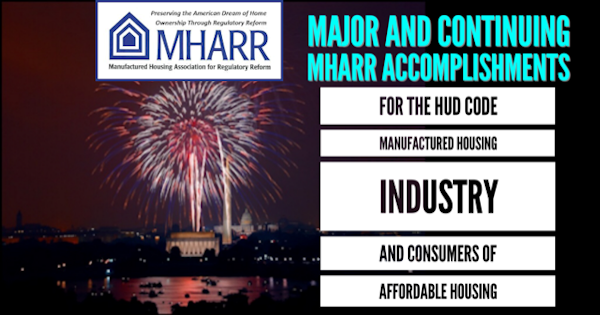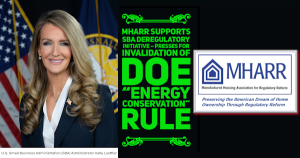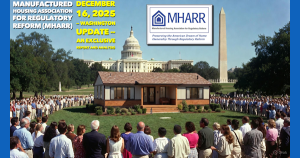Updated May 1, 2024
Among many other significant accomplishments on behalf of the HUD Code manufactured housing industry and American consumers of affordable, non-subsidized manufactured housing MHARR, since its founding in 1985, has:
- Led the industry in securing the enactment of the Manufactured Housing Improvement Act of 2000 (2000 Reform Law), which mandated specific accountability-based reforms for the federal manufactured housing program at the U.S. Department of Housing and Urban Development (HUD), directed the appointment of a non-career program administrator, established an enhanced level of federal preemption as the foundational basis for combatting longstanding discriminatory zoning exclusion of manufactured homes and lower/moderate-income manufactured housing consumers, established the Manufactured Housing Consensus Committee (MHCC) to curb the program’s runaway regulatory activity and ensure cost-effective regulation[1] and, ultimately was designed to transform the treatment of HUD Code homes from the “trailers” of yesteryear to legitimate, modern, affordable, energy-efficient permanent “housing” for all purposes. Unfortunately, notwithstanding this major accomplishment and Congress’ effort thereby to propel inherently affordable manufactured housing to a more significant position in the overall housing market, HUD, more than two decades later, continues to fail in the implementation of – or otherwise ignore – key reform provisions of the 2000 law, which would increase both the availability and utilization of the manufactured housing which HUD itself regulates.
- Led the industry in developing and securing enactment of the Duty to Serve Underserved Markets (DTS) provision of the Housing and Economic Recovery Act of 2008 (HERA), which directs the Government Sponsored Enterprises (GSEs) (e., Fannie Mae and Freddie Mac) to securitize both real estate and personal property (i.e., chattel) manufactured home consumer loans. MHARR became involved in this finance-related, post-production matter because the lack of an effective, independent, national representative for the industry’s post-production sector had allowed the GSEs to avoid the manufactured housing market almost entirely, in direct violation of their Charter obligations to help promote homeownership for all Americans, including lower and moderate-income families. Nearly two decades after the enactment of DTS, its implementation, particularly within the dominant personal property/chattel lending segment of manufactured home consumer lending, remains a continuing issue, with MHARR aggressively seeking market-significant implementation of DTS with respect to such personal property/chattel loans, which comprise nearly 80% of the manufactured home financing market.
- Led the industry in seeking changes to the leadership of the HUD manufactured housing program following unreasonable regulatory actions and arguably unlawful restrictions were placed on the legitimate design and use of manufactured homes, while promoting the full and legitimate accountability of the program to senior HUD leadership, and both presidential and congressional authority as mandated by law.
- Led – and continues to lead – the effort to implement major reforms to the HUD manufactured housing program contracting process which has, for nearly a half-century, resulted in the “selection” of the same program monitoring contractor (albeit under differing corporate names) without full, fair, or even adequate competition, as required by applicable law.
- Led – and continues to lead – the industry in opposing excessive and discriminatory manufactured housing “energy conservation” regulations being pursued by the U.S. Department of Energy (DOE).
- Has led in fighting against discriminatory and exclusionary local zoning and placement ordinances which prohibit or unreasonably restrict the availability and utilization of HUD Code manufactured housing.
- Led the industry in ensuring the establishment of a firewall between specifications for manufactured homes purchased for emergency use by the Federal Emergency Management Agency (FEMA) and general consumer market manufactured homes, thus ensuring the continued affordability and price stability of HUD Code manufactured homes.
- Led the industry in the establishment of a firewall between accessibility standards for manufactured homes purchased for emergency use by FEMA and general consumer market manufactured homes, thus ensuring the continued affordability and price stability of HUD Code manufactured homes, while simultaneously promoting full compliance of emergency housing with the Americans with Disabilities Act and related federal accessibility laws.
- Leads the industry in ensuring that the long-term collective memory of industry, its institutional memory and its long-term regulatory knowledge and expertise are represented in – and considered by – the MHCC, HUD and Congress in all decisions relating to the regulation of HUD Code manufactured homes.
- Leads the industry in monitoring Congress, all federal agencies and courts for decisions that may negatively impact HUD Code manufactured housing and American consumers of affordable housing, and taking follow-up action(s) as appropriate and warranted.
- Notwithstanding these accomplishments and efforts, three major bottlenecks continue to persist and restrict both the production and utilization of affordable, mainstream federally-regulated manufactured homes. These bottlenecks include discriminatory and exclusionary local zoning mandates, the ongoing failure of Fannie Mae and Freddie Mac to implement DTS with the manufactured home consumer personal property/chattel lending market, and the looming threat of excessive, discriminatory, unreasonable and unreasonably costly DOE manufactured housing “energy conservation” standards. MHARR will continue to sharply focus on all of these significant matters.
- Led the industry in seeking the repeal or substantial reform of the Ginnie Mae “10-10” issuer qualification rule that (since 2010) had reduced Federal Housing Administration (FHA) Title I manufactured home consumer loan originations to near-zero levels. Consistent MHARR interaction with Ginnie Mae officials, including a crucial meeting in February 2022 regarding the destructive impact of the 10-10 rule, led to a substantial easing of the rule, announced by Ginnie Mae in February 2024.
- Led the industry in opposing baseless HUD efforts to limit manufactured homes to single-living-unit structures, notwithstanding the absence of any corresponding statutory support in the National Manufactured Housing Construction and Safety Standards Act of 1974 (as amended) for such a restriction. MHARR then led the industry in seeking and developing standards for multi-unit manufactured homes. Standards for multi-living-unit manufactured homes were adopted/announced by HUD on September 11, 2024.
- The foregoing MHARR document is available for re-publication in full (i.e., without alteration or substantive modification) with specific written permission and with proper attribution and/or link back to MHARR.
MHARR is a Washington, D.C.-based national trade association representing the views and interests of independent producers of federally-regulated manufactured housing.
[1] The MHCC, established by the Manufactured Housing Improvement Act of 2000, is the centerpiece manufactured housing program reform mandated by that law. Designed to ensure the consensus development and interpretation of both standards and enforcement regulations, as well as adherence to notice and comment rulemaking and all other procedural safeguards, the MHCC is comprised of three groups of individuals – users, producers and general interest – appointed by the Secretary of HUD.
Updated May 1, 2024
The Manufactured Housing Association for Regulatory Reform (MHARR) was established on July 3, 1985 as the “Association for Regulatory Reform” (ARR). The Association adopted its current name in 1997.
Based in Washington, D.C. since its founding. MHARR was formed to represent the views and interests of producers of manufactured housing. A major source of the nation’s supply of non-subsidized affordable homes, the manufactured housing industry is federally regulated by the U.S. Department of Housing and Urban Development (HUD) – the only segment of the housing industry to be regulated at the federal level.
MHARR was formed by smaller and medium-sized independent producers of HUD-regulated manufactured housing when it became apparent: (1) that the HUD regulatory program established by the National Manufactured Housing Construction and Safety Standards Act of 1974 (1974 Act) was careening off-course in ways that were contrary to its legislative purposes as well as the interests of both the industry and consumers; and (2) that the special needs of manufacturers, as regulated parties, were not fully and effectively represented and advanced in the nation’s capital.
Given its founding impetus, MHARR is dedicated to maintaining a HUD regulatory framework which promotes both the availability and affordability of manufactured housing – an objective now enshrined in federal law thanks to the Manufactured Housing Improvement Act of 2000 (2000 Reform Law) which MHARR successfully sought, promoted and advanced to enactment. The primary and enduring mission of MHARR, accordingly, is to protect, defend and advance the interests of its members and the manufactured housing lifestyle for American consumers of affordable housing.
Within the broader HUD Code industry, the voice of manufacturers – the segment of the industry most directly impacted by federal regulation – has tended to be merged with that of other segments of the industry, including retailers, suppliers, finance companies and community developers. Each such segment has its own specific interests and perspective(s) but unless manufacturers’ views can be articulated, published and advocated independently, the representation of those views is unavoidably weakened by being merged within an “umbrella” representation, which inevitably devolves to the lowest common denominator position among the diverse segments of the industry.
The industry has also witnessed the emergence of a new type of manufacturer with large retail and financing affiliates. That segment of the industry may also have different needs than smaller and medium-sized independent manufacturers. Consequently, the primary objective of the Manufactured Housing Association for Regulatory Reform is to enunciate the consensus view of manufacturers, so that their experience, understanding and approach is considered in any law, rule, standard and/or regulation that is imposed on the industry.
Since MHARR’s establishment, the production of manufactured housing has become increasingly competitive and complex. As the industry has matured, numerous federal, state and local agencies have sought to impose rules and regulations that could significantly impact the cost and availability of manufactured housing as a prime non-subsidized affordable housing resource for Americans at every rung of the economic ladder. Given this reality and particularly in light of the fact that the HUD manufactured housing program is based on a statutory federal-state partnership at its core, MHARR has continuously been involved at all levels of government – federal, state and local – to protect, defend and advance the interests of both manufactured housing producers and consumers.
Necessarily, though, the interests of HUD Code manufacturers and consumers are unavoidably impacted by activity and developments affecting the post-production sector of the industry (i.e., activity and developments affecting manufactured homes and consumers once such homes leave the factory). Such activity – by governmental or quasi-governmental actors – can negatively impact both the availability and utilization of manufactured housing for large segments of the public and can significantly constrain that availability, to the extreme detriment of all concerned. Current examples of this phenomenon include the failure of the Government Sponsored Enterprises (GSEs) to provide securitization and secondary market support for personal property manufactured home consumer loans in accordance with existing law and discriminatory/exclusionary zoning and placement restrictions on manufactured homes in many more densely-populated areas of the United States, also in defiance of existing law. Because of this indisputable reality and the fact that the long-term absence of any type of independent, dedicated national representation for the industry’s post-production sector has allowed such problems to multiply and fester, MHARR has taken — and will continue to take – the lead on these matters as well.
Ultimately, though, it is axiomatic that there is no regulation without economic cost, particularly for a comprehensively federally-regulated industry such as manufactured housing. That cost, inevitably, is passed along to the purchaser of the home. Overall, therefore, MHARR seeks an improved environment for the growth of the manufactured housing industry and for the availability of affordable mainstream manufactured housing to all American consumers through fair, reasonable and cost-effective federal regulation. Furthermore, the Association is dedicated to reassessing all existing laws and regulations periodically to determine their cost, validity and relevance, and to measuring each new law and/or regulation against those same criteria, with the principal objective of securing protection for manufactured housing consumers – comprised primarily of lower and moderate-income American families – while simultaneously ensuring the continuing availability of safe, affordable, energy-efficient and, to the maximum degree possible, non-subsidized high-quality manufactured homes.













